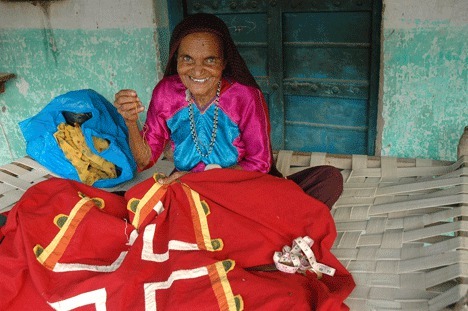They hail from distant nomadic communities in Western India, bearing some of the most beautiful embroidered pieces in the world. And they’ve traveled to Whidbey Island.
The group of 13 Indian artisans are Nomadic Rabaris from the desert Kutch area of India, a people who wander annually in search of grazing areas for their sheep and camels. In addition to maintaining a nomadic lifestyle, they also happen to be some of the best embroiderers, appliqué and tie-dye artists in the world.
Their trip is made possible by the American textile expert Judy Frater. Frater started a national government organization called Kala Raksha and has lived among the Rabaris for more than 20 years, documenting their work and providing them with a system to sell their crafts at home and in the world marketplace.
Frater will introduce the Rabari women at a trunk show of their work from 5 to 7 p.m. Tuesday, July 20 at Langley’s rug shop, Music for the Eyes. She will also speak about her experience with the Rabari people.
Frater’s book, “Threads of Identity: Embroidery and Adornment of the Nomadic Rabaris,” is a seminal, in-depth look at the art of a people through more than 10 centuries, and recounts the Rabaris’ spread to various regions of their subcontinent and their preservation of their identity through adornment.
Following the trunk show, the group will hold a textile workshop at the Gail Harker Creative Studies Center in Oak Harbor from 10 a.m. to 6 p.m. Wednesday, July 21.
Local surface design artist Zia Gipson became reacquainted with Frater, formerly of Seattle, while traveling in India. She suggested the Rabari women make a stop on Whidbey Island after their visit to Santa Fe, N.M.
In somewhat of a coup, the craftswomen were invited to the Santa Fe International Art Market, a prestigious honor as only a certain number of fiber artists from all parts of the world are asked to attend. It is the largest international folk-art market in the world.
Island artisans as well as admirers of art will appreciate the excellence of these impeccably detailed pieces of Indian craft.
They may also enjoy meeting the artists themselves.
One of the visiting artists is Harkhuben Bhojraj Rabari. She grew up in a family of camel herders and learned embroidery from her mother in 1962 when, at the age of 15, she began work on her wedding dowry.
Her skills in mud-relief work, beadwork and appliqué, in addition to her innovative and intricate embroidery, have won coveted awards and earned her a position as both teacher and product designer for the Kala Raksha.
Also visiting will be Meghiben Meriya, an accomplished appliqué embroiderer who stitches complex narratives depicting women’s lives in Kutch.
Of her work, she said, “These are my childhood memories … I believe we should remember all the struggles we faced in our life.”
Dedicated to the preservation of the traditional arts of ethnic communities of Kutch, the nonprofit Kala Raksha champions fair-trade practices and involves artists in the pricing and marketing of their own products. It also provides preventative healthcare, basic education programs and micro-credit savings groups to achieve holistic community development for traditional artists and their families.
Gipson said it was Ghandi who, as a young man, began encouraging local cottage industries such as spinning fiber to sustain the Indian people so they wouldn’t need to buy their thread from Britain. Now there are sustainable communities of artists throughout the country.
Gipson recalled a visit to a woman’s home while in India. There was a stack of flat textiles in one corner of the room that was four feet high, which she was admiring. Before she knew it, the room was full of about 40 women all wanting to show her what they had made; teenagers holding baby siblings, mothers, grandmothers and great-grandmothers, all smiling.
“We couldn’t understand anything they said, but everyone was laughing. It was just lovely,” Gipson said.
Visit www.musicfortheeyes.com for more info on the Langley event. Visit www.gailcreativestudies.com for the Oak Harbor workshop.



